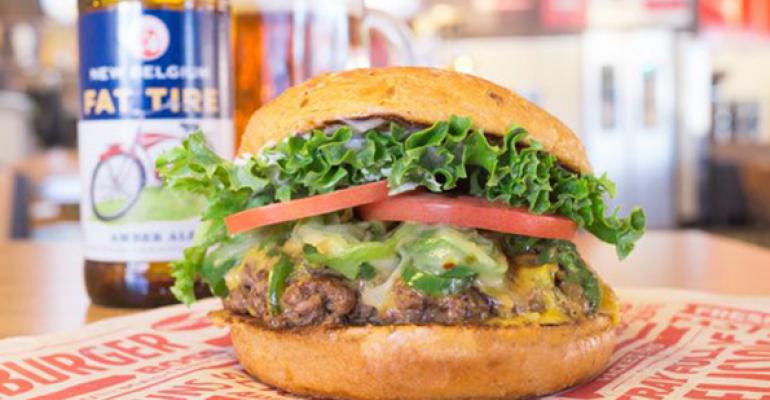
Smashburger was founded in 2007, and now has more than 300 locations. The chain has been an early leader in the fast-casual segment. I had the chance to speak with CMO Josh Kern about being one of the leaders in the better burger space.
How is Smashburger different from its better burger competitors?
We’re not here to debate the burgers past. We’ve evolved. Moved on. We’ve wiped the slate clean and started over with a modern brand and a modern burger experience. The future of burgers isn’t just buying whatever the restaurant makes. We embrace deviation, customization and personalization. You design your meal. Choose from unique flavors of the freshest ingredients, and then complement it with delicious sides and craft and local beers. Smashburger is all about choice, from Angus burgers, all-white-meat chicken, black bean burgers or salads — all made to order.
What does the “Smash” in Smashburger stand for?
Smashburger burgers are built on a foundation of 100-percent certified Angus beef that’s fresh, never frozen. Smashed on a hot, buttered grill to seal in the flavor and served with premium toppings on an artisan bun. A burger that’s true to you and your taste buds.

What are you seeing in the restaurant industry? What trends do you see in fast casual particularly?
The rapid adoption of technology. From the way guests order either from a mobile perspective, a social interaction or even with evolution of a new way to have such quality food delivered. Fast-casual outlets are moving fast and all trying to see how the digital customer journey evolves. I am really excited to see so many great brands breaking barriers and embracing technological tools every day.
What has been one of Smashburger’s biggest recent successes?
I try to paint a picture of success for every challenge or initiative that comes the way of Smashburger with the mantra: “Believe in your mind that you can, and you will.” Most of all I am really proud of building teams. I set high expectations for the marketing team, and I also believe in the freedom to fail, all in the interest of never settling and always exploring that next big idea.
What trends are you seeing in restaurant marketing?
The most overused phrase — targeting Millennials. I have seen restaurant marketers make an investment in the visual nature of their brands. Storytelling is a buzzword, and a lot of people talk about it, but for Millennials the visual piece — honing photography and creative assets — helps attract and convert Millennials. The visual aspect goes hand in hand with real-time marketing, another trend I have been seeing in the restaurant space — brands reacting to a topic or trend quickly and then adjusting. The Millennial audience appreciates when we react and adjust accordingly. It helps us stay on top of the trends.
Finally, I’m a believer in good, old-fashioned surveying of the customer and asking them what they want and who they are, a trend that is making its way back when I talk to other marketers at various events.
How do you think restaurants can use PR as a way to drive sales?
PR is most valuable for generating awareness, but it can fulfill other roles. PR is key to influencing audience behaviors, making it the secret weapon to promote storytelling of your brand. Getting your brand and its experts in the news is a powerful way to get your brand in front of more people. It increases visibility and brand awareness. Most importantly, when you’re in the news without paying to be there, as opposed to buying advertising, it enhances your credibility.
It’s easier to sell to people who have heard of your company and believe it to have a strong reputation. With PR Content Marketing Programs fully integrated — blogging, e-newsletters, online video and social media help restaurants stay top-of-mind among media prospects and referral sources. Compelling stories — in both written and visual form — have a greater chance of capturing someone’s attention and engaging them in our message. Content marketing also educates people about what you do or sell and positions your experts (founders, chefs, etc.) as thought leaders in the restaurant industry. Online content is sharable, meaning the message is diffused well past initial circle of media and influencers, and can be used to funnel future messaging.
What role does marketing play in the growth of a brand? And how has it supported Smashburger?
We’ve leveraged marketing to drive our overall growth strategy by focusing on three big things from a marketing standpoint. One was modernizing our brand and what we stood for. Another was changing our go-to-market strategy — we’ve shifted from just being product-focused to persona- and people-focused. The third piece was how to scale our growth and pipeline against that.
What is your personal philosophy on marketing?
The most predetermined resource we have on this planet is time, so think big. This philosophy has driven me more than anything else. Going big doesn’t mean being flashy or puffing out your chest; it means thinking at scale. Are you spending your precious time on something that is truly meaningful? Is the world a better place for having you and your work a part of it?
Favorite quote?
“You know you're in love when you can't fall asleep because reality is finally better than your dreams.” ―Dr. Seuss





